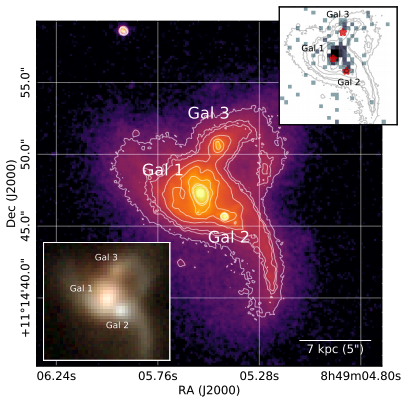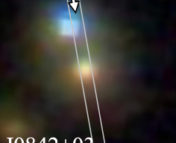Title: A Triple AGN in a Mid-Infrared Selected Late Stage Galaxy Merger
Authors: Ryan W. Pfeifle, Shobita Satyapal, Christina Manzano-King, Jenna Cann, et al.
First Author’s Institutions: George Mason University, Department of Physics
Status: Open access on ArXiv
What are AGN and why do I care?
An AGN, or Active Galactic Nucleus, is the epitome of a fascinating and truly awesome astrophysical object. An AGN consists of a black hole that happens to be surrounded by gas and dust that is close enough to form an accretion disk and fall into the black hole. As a result, the black hole (now AGN) forms these enormous, extremely bright, and hottt jets. AGNs are quite useful for those interested in learning more about black holes (who isn’t), but black holes on their own don’t emit any sort of radiation. It’s only when they come in contact with or are in front of other things that we can directly detect, can we then indirectly learn about this incredible astrophysical phenomena. Astronomers are particularly interested in super massive black holes, which seem to be in the center of the vast majority of galaxies. Super massive black holes also seem to co-evolve with their host galaxy, at least according to the most popular theory of cosmology: ΛCDM. It’s quite interesting actually, to think that a single super massive black hole in the center of the galaxy, while being very massive for a single object, could potentially govern the evolution of its entire host galaxy which is much much larger and more massive. For example, the super massive black hole in the center of the Milky Way is about 3 million solar masses while being about a light minute in diameter but compare that to the Milky Way, and it is 150 BILLION solar masses and over 50,000 light years wide. How could that relatively small black hole have such an impact on an entire galaxy?
Since AGNs are super bright, astronomers can detect them from very far away. This allows us to explore how supermassive blackholes affect galaxy evolution across cosmic time. AGN only exist where there is an excess amount of dust and gas in a galaxy. Nowadays, when we look at nearby galaxies, they are lacking in dust and gas compared to galaxies at redshift of 2. Galaxies that are at redshift of 2 mean that we are looking back to a time where the galaxy was only about a quarter of its current age. Back then, galaxies contained a TON of gas and dust that was used for star formation, and was fuel for AGN. This is a key redshift that astronomers want to probe to understand how galaxies evolve to what they are today.
Where does the triple AGN come in?
One of the main drivers of galaxy evolution are galaxy mergers. The math is simple: galaxy + galaxy = bigger galaxy. When two galaxies collide, the stars inside of them don’t run into each other, but the gas and dust in each galaxy do collide and interact, producing starburst events and, you guessed it, powering AGN! So if we wanted to hunt down some AGN, mergers are a fantastic place to start. Cosmological simulations even predict that ~16% of all mergers actually contain three galaxies, or a triple merger. This offers up the possibility of a triple merging system where each of the galaxies involved in the collision have an active galactic nucleus. If we believe our modern theory of the universe ( ΛCDM), triple AGN systems must exist, but since there is going to be a lot of dust in the system, they could be obscured behind thick sheets of dust. That plus their rarity makes these systems difficult to detect. Today’s paper offers up a proposed detection of such an object.
The Detection of a Triple AGN
Detecting AGN is not always straight-forward. The signal that AGN produce are similar to other high-energy phenomena in the universe, so in order to be absolutely sure you have detected an AGN, you need to use the full electromagnetic spectrum. AGN flux peaks at X-ray wavelengths, so you definitely want to use the Chandra and NuStar observatories. AGN also have specific optical signature to look out for, so you can use a big ol’ optical telescope like the Large Binocular Telescope, and optical surveys like SDSS. And due to the dust surrounding the AGN, it’s original emission will be reddened, and even the dust itself can be visible in infrared wavelengths. This paper utilized telescopes that operate in each of these wavelengths to confirm a triple AGN system. (Radio is also useful, and they say that they are working on another paper that will include the radio data).

To validate their claim of an AGN system, this paper also explored some other possible explanations for each of their detections, and ruled each of them out. One alternate explanation is star formation. I mentioned that at around the same time AGN become active, star formation is also very active. Could star formation explain the x-ray emission this paper reports? To answer that they turned to their optical data. Using spectral lines specific to star formation signatures, they were able to calculate the star formation rate needed to explain the optical emission they receive. Then, using that rate they calculated how much x-ray emission would be expected, and it’s an order of magnitude (10X) lower than what they see in x-rays. Okay, so star formation won’t cut it. What about ionized shocks? A shock can be produced by a sudden change in pressure, usually associated with supernova. They are bright and high energy, could that be causing the x-ray signature they see? It could explain both the x-ray and optical luminosity they receive, however, the optical spectroscopy is missing some signatures that would be present if there were shocks. Plus, it would be super rare for three shocks to just so happen near the center of each galaxy.

Given the x-ray, optical, and IR data of this system, this paper concludes with some certainty that they have discovered a triple AGN system. This triple AGN system surely will receive more follow up study, and the obvious next step is to search for more! This triple AGN detection is so special because it is predicted by ΛCDM as well as an added bonus of offering a solution to the final parsec problem. Hopefully with a handful of known triple AGN we can start to test our current theories of physics that govern the universe.





Nice. Some fine points…accepted value for milky way bh is more like 4e6.
Peak in energy spectrum vLv is usually fuv, not x.
And a recent paper by Zoghbi et al., mostly about ngc4151, casts doubt on the ngc1365 spin measurement.